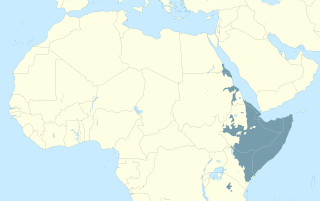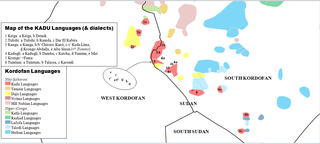Related Research Articles

The Chadic languages form a branch of the Afroasiatic language family. They are spoken in parts of the Sahel. They include 196 languages spoken across northern Nigeria, southern Niger, southern Chad, and northern Cameroon. By far the most widely spoken Chadic language is Hausa, a lingua franca of much of inland Eastern West Africa, particularly Niger and the northern half of Nigeria. Hausa, along with Mafa and Karai Karai, are the only three Chadic languages with more than 1 million speakers.

The Cushitic languages are a branch of the Afroasiatic language family. They are spoken primarily in the Horn of Africa, with minorities speaking Cushitic languages to the north in Egypt and Sudan, and to the south in Kenya and Tanzania. As of 2012, the Cushitic languages with over one million speakers were Oromo, Somali, Beja, Afar, Hadiyya, Kambaata, and Sidama.
The Eastern Nilotic languages are one of the three primary branches of the Nilotic languages, themselves belonging to the Eastern Sudanic subfamily of Nilo-Saharan; they are believed to have begun to diverge about 3,000 years ago, and have spread southwards from an original home in Equatoria in South Sudan. They are spoken across a large area in East Africa, ranging from Equatoria to the highlands of Tanzania. Their speakers are mostly cattle herders living in semi-arid or arid plains.
The Southern Nilotic languages are spoken mainly in western Kenya and northern Tanzania. They form a division of the larger Nilotic language family, along with the Western Nilotic languages and the Eastern Nilotic languages.
The Elgeyo language, or Kalenjin proper, are a dialect cluster of the Kalenjin branch of the Nilotic language family.
The Maa languages are a group of closely related Eastern Nilotic languages spoken in parts of Kenya and Tanzania by more than a million speakers. They are subdivided into North and South Maa. The Maa languages are related to the Lotuko languages spoken in South Sudan.
Samburu is a Maa language dialect spoken by Samburu pastoralists in northern Kenya. The Samburu number about 128,000. The Samburu dialect is closely related to the Camus dialect and to the South Maasai dialects. The word "Samburu" itself may derive from the Maa word saamburr for a leather bag the Samburu use.

The Ilchamus, are a Maa-speaking people living south and southeast of Lake Baringo, Kenya. They numbered approximately 32,949 people in 2019 and are closely related to the Samburu living more to the north-east in the Rift Valley Province. They are one of the smallest ethnic groups in Kenya.

The Kadu languages, also known as Kadugli–Krongo or Tumtum, are a small language family of the Kordofanian geographic grouping, once included in Niger–Congo. However, since Thilo Schadeberg (1981), Kadu is widely seen as Nilo-Saharan. Evidence for a Niger-Congo affiliation is rejected, and a Nilo-Saharan relationship is controversial. A conservative classification would treat the Kadu languages as an independent family.
The Surmic languages are a branch of the Eastern Sudanic language family.
The Dholuo dialect or Nilotic Kavirondo, is a dialect of the Luo group of Nilotic languages, spoken by about 4.2 million Luo people of Kenya and Tanzania, who occupy parts of the eastern shore of Nam Lolwe and areas to the south. It is used for broadcasts on Ramogi TV and KBC.
Bari is the Nilotic language of the Karo people, spoken over large areas of Central Equatoria state in South Sudan, across the northwest corner of Uganda, and into the Democratic Republic of Congo.
The Kuku dialect, also called Kutuk na Kuku belongs to the Karo language group, of the Southeastern Nilotic branch of the Nilotic language family of Southern Sudan and Northern Uganda. There is no standardized writing system for Kuku; it is sometimes written using the alphabet of a related language such as Bari or Kakwa, with the addition of characters to represent sounds that are not present in the other language. For example, the Bari alphabet can be adjusted for use in Kuku by adding the digraphs gb and kp to represent the voiced and voiceless labiovelar stops, respectively.

The Majang language is spoken by the Majangir people of Ethiopia. Although it is a member of the Surmic language cluster, it is the most isolated one in the group. A language survey has shown that dialect variation from north to south is minor and does not seriously impede communication. The 2007 Ethiopian Census lists 6,433 speakers for Majang (Messengo), but also reports that the ethnic group consists of 32,822 individuals. According to the census, almost no speakers can be found in Mezhenger Zone of Gambela Region; a total of eleven speakers are listed for the zone, but almost 10,000 ethnic Mejenger or Messengo people.
Komo is a Nilo-Saharan language spoken by the Kwama (Komo) people of Ethiopia, Sudan and South Sudan. It is a member of the Koman languages. The language is also referred to as Madiin, Koma, South Koma, Central Koma, Gokwom and Hayahaya. Many individuals from Komo are multilingual because they are in close proximity to Mao, Kwama and Oromo speakers. Komo is closely related to Kwama, a language spoken by a group who live in the same region of Ethiopia and who also identify themselves as ethnically Komo. Some Komo and Kwama speakers recognize the distinction between the two languages and culture, whereas some people see it as one "ethnolinguistic" community. The 2007 Ethiopian census makes no mention of Kwama, and for this reason its estimate of 8,000 Komo speakers may be inaccurate. An older estimate from 1971 places the number of Komo speakers in Ethiopia at 1,500. The Komo language is greatly understudied; more information is being revealed as researchers are discovering more data about other languages within the Koman family.

Tangale (Tangle) is a West Chadic language spoken in Northern region of Nigeria. The vast majority of the native speakers are found across Akko, Billiri, Kaltungo and Shongom Local Government Area of Gombe State Nigeria.
The Lopit language is an Eastern Nilotic language spoken by around 117,000 people in Eastern Equatoria State, South Sudan. Lopit is part of the Lotuko-Teso subfamily and is related to Lotuko, Turkana and Maasai. Lopit is a VSO language and has a complex tonal system.
Toposa is a Nilo-Saharan language spoken in South Sudan by the Toposa people. Mutually intelligible language varieties include Jiye of South Sudan, Nyangatom of Ethiopia, Karimojong, Jie and Dodos of Uganda and Turkana of Kenya. Teso is lexically more distant.
Dongotono is an Eastern Nilotic language spoken by an estimated 5,000 people in South Sudan.
Rainer Vossen is a German linguist and Africanist. His research interests include the historical linguistics of Nilotic languages and Khoisan languages.
References
- 1 2 3 4 Lokoya at Ethnologue (25th ed., 2022)

- ↑ Vossen, Rainer (1982). The Eastern Nilotes: Linguistic and Historical Reconstructions. Berlin: Dietrich Reimer Verlag.
- ↑ Vossen, Rainer (1982). The Eastern Nilotes: Linguistic and Historical Reconstructions. Berlin: Dietrich Reimer Verlag. p. 111.
- ↑ Vossen, Rainer (1982). The Eastern Nilotes: Linguistic and Historical Reconstructions. Berlin: Dietrich Reimer Verlag. pp. 166–167.
- ↑ Lomodong, Anthony (2006). "A brief history of the Lokoya of Sudan". Lokoya of Sudan. Retrieved 9 Jan 2015.
- ↑ Lomodong, Anthony (2006). "Lokoya territory". Lokoya of Sudan. Retrieved Jan 9, 2015.
- ↑ "Lokoya". Gurtong. 2014. Retrieved Jan 9, 2015.
- ↑ Vossen, Rainer (1982). The Eastern Nilotes: Linguistic and Historical Reconstructions. Berlin: Dietrich Reimer Verlag. pp. 189–192.
- ↑ Vossen, Rainer (1982). The Eastern Nilotes: Linguistic and Historical Reconstructions. Berlin: Dietrich Reimer Verlag. p. 192.
- ↑ Vossen, Rainer (1982). The Eastern Nilotes: Linguistic and Historical Reconstructions. Berlin: Dietrich Reimer Verlag. p. 193.
- ↑ Vossen, Rainer (1982). The Eastern Nilotes: Linguistic and Historical Reconstructions. Berlin: Dietrich Reimer Verlag. p. 193.
- ↑ Vossen, Rainer (1982). The Eastern Nilotes: Linguistic and Historical Reconstructions. Berlin: Dietrich Reimer Verlag. pp. 213–219.